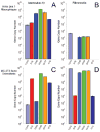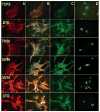Cellular response to phase-separated blends of tyrosine-derived polycarbonates
- PMID: 16278865
- PMCID: PMC2996268
- DOI: 10.1002/jbm.a.30527
Cellular response to phase-separated blends of tyrosine-derived polycarbonates
Abstract
Two-dimensional thin films consisting of homopolymer and discrete compositional blends of tyrosine-derived polycarbonates were prepared and characterized in an effort to elucidate the nature of different cell responses that were measured in vitro. The structurally similar blends were found to phase separate after annealing with domain sizes dependent on the overall composition. The thin polymer films were characterized with the use of atomic force microscopy (AFM), water contact angles, and time-of-flight secondary ion mass spectrometry (TOF-SIMS) and significant changes in roughness were measured following the annealing process. Genetic expression profiles of interleukin-1beta and fibronectin in MC3T3-E1 osteoblasts and RAW 264.7 murine macrophages were measured at several time points, demonstrating the time and composition-dependent nature of the cell responses. Real-time reverse transcriptase polymerase chain reaction (RT-PCR) depicted upregulation of the fibronectin gene copy numbers in each of the blends relative to the homopolymers. Moreover, the interleukin-1beta expression profile was found to be compositionally dependent. The data suggest strongly that optimal composition and processing conditions can significantly affect the acute inflammatory and extracellular matrix production responses.
(c) 2005 Wiley Periodicals, Inc.
Figures






References
-
- Karim A, Douglas JF, Sung LP, Ermi BD. Self assembly by phase separation in polymer thin films. In: Buschow KHJ, Cahn RW, Flemmings MC, Ilschner B, Kramer EJ, Mahajan S, editors. Encyclopedia of materials: science and technology. Elsevier Science; 2002. pp. 8319–8322.
-
- Kohn J. New approaches to biomaterials design. Nat Mater. 2004;3:745–747. - PubMed
-
- Smith JR, Seyda A, Weber N, Knight D, Abramson S, Kohn J. Integration of combinatorial synthesis, rapid screening, and computational modeling in biomaterials development. Macromol Rapid Commun. 2004;25:127–140.
-
- Washburn NR, Yamada KM, Simon CG, Kennedy SB, Amis EJ. High-throughput investigation of osteoblast response to polymer crystallinity: influence of nano-scale roughness on proliferation. Biomaterials. 2004;25:1215–1224. - PubMed
-
- Meredith JC, Sormana JL, Keselowsky BG, Garcia AJ, Tona A, Karim A, Amis EJ. Combinatorial characterization of cell interactions with polymer surfaces. J Biomed Mater Res A. 2003;66:483–490. - PubMed
Publication types
MeSH terms
Substances
Grants and funding
LinkOut - more resources
Full Text Sources
Miscellaneous

